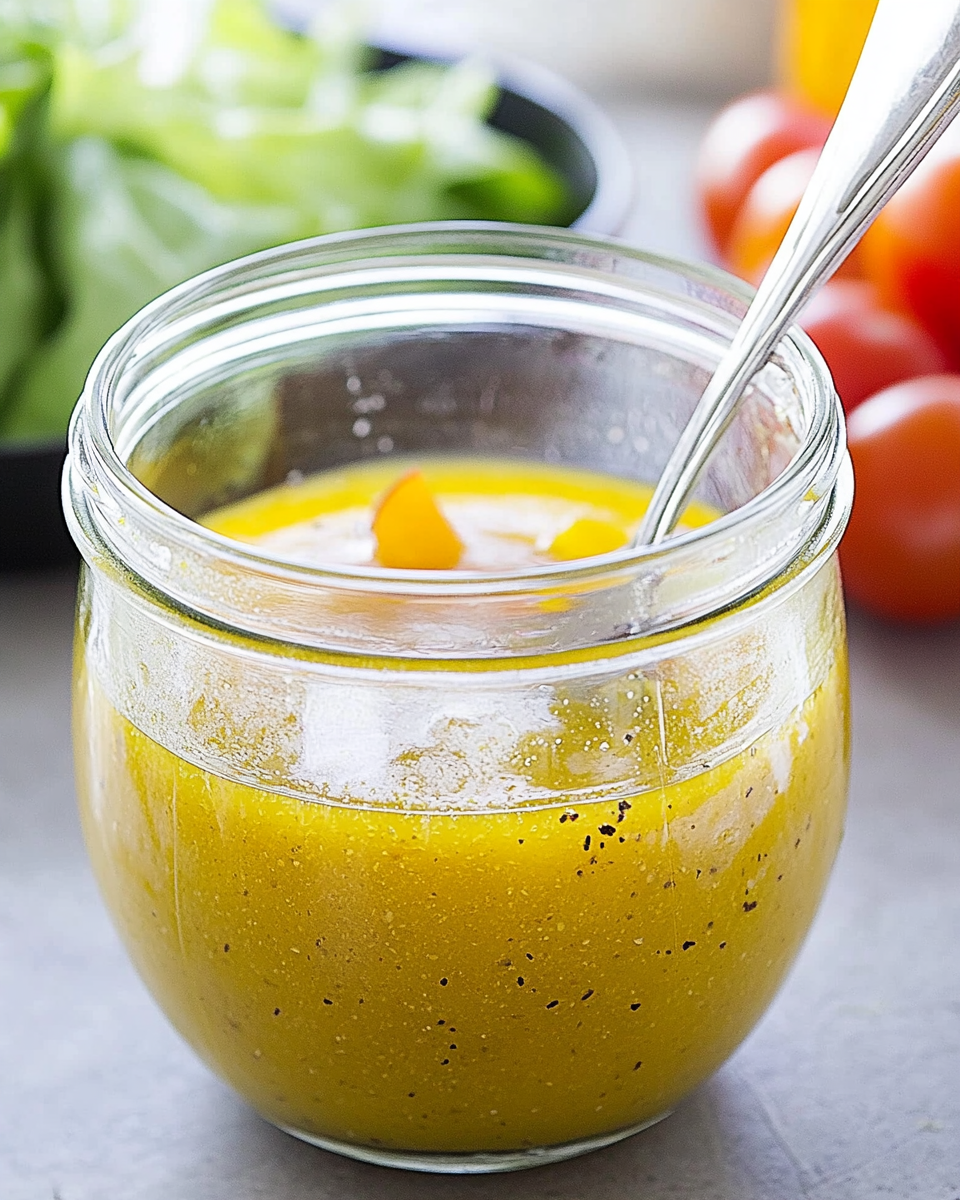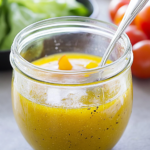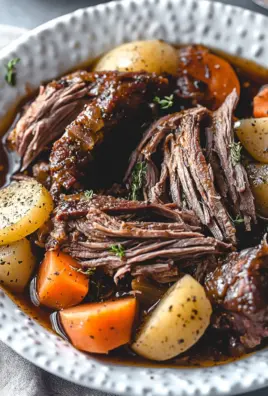A Simple Vinaigrette is one of the most versatile and essential recipes in any kitchen. Whether you are dressing a crisp green salad, drizzling over roasted vegetables, or using it as a marinade, this classic dressing adds fresh, tangy flavor to almost any dish. The beauty of a homemade vinaigrette lies in its simplicity — it requires just a handful of pantry staples, takes only a few minutes to make, and can be customized to suit your preferences.

Unlike store-bought dressings that often contain preservatives, artificial flavors, and excess sugar, a homemade simple vinaigrette allows you to control every ingredient. That means better quality, fresher taste, and a healthier option for your meals. From weeknight dinners to elegant holiday salads, this dressing fits seamlessly into any menu.
What Makes This Recipe Special
- Uses pantry staples you likely already have.
- Comes together in under 5 minutes.
- Adaptable with various vinegars, oils, and sweeteners.
- Stores well for up to two weeks.
- Elevates salads, vegetables, grain bowls, and proteins.
If you have ever felt overwhelmed by the variety of store-bought dressings, learning to make your own simple vinaigrette is a game-changer. It is the perfect balance of acidity, sweetness, and richness, and you can adjust every element to your taste.
Essential Tools & Preparation Tips
Making vinaigrette requires just a few basic tools, but choosing the right ones can make the process faster and ensure a smooth, well-emulsified dressing.
Tools You’ll Need
- Mason jar with lid – Ideal for shaking the dressing to emulsify and easy for storage.
- Small whisk – Perfect for mixing when you prefer a bowl over a jar.
- Measuring spoons and cups – Ensures the right balance of oil, vinegar, and seasonings.
- Small mixing bowl – Great for whisking the ingredients if you want to avoid shaking.
Why These Tools Matter
A tightly sealed jar allows you to combine and store the vinaigrette in the same container, reducing cleanup. A whisk gives you more control over the texture if you prefer adjusting the dressing as you mix. Accurate measuring tools help maintain the proper oil-to-vinegar ratio, which is essential for a balanced dressing.
Ingredients
Core Ingredients
- ¼ cup extra virgin olive oil
- 2 tablespoons apple cider vinegar (swap with white wine vinegar, red wine vinegar, or balsamic vinegar if desired)
- 1 ½ teaspoons honey (use pure maple syrup for a vegan option)
- ½ teaspoon Dijon mustard
- ⅛ teaspoon kosher salt (or fine sea salt)
- Freshly ground black pepper, to taste
Substitution Notes
- Use avocado oil or grapeseed oil if you prefer a more neutral base.
- Replace Dijon mustard with whole grain mustard for extra texture.
- Swap apple cider vinegar for a milder option like champagne vinegar if desired.
Step-by-Step Directions
Step 1: Combine Ingredients
Add all the ingredients directly into a mason jar or a small mixing bowl. Layer the oil first, followed by vinegar, honey, mustard, salt, and pepper.
Step 2: Mix the Vinaigrette
- If using a jar, secure the lid tightly and shake vigorously for about 20 to 30 seconds until the mixture is fully emulsified.
- If using a bowl, whisk the ingredients thoroughly until they combine into a smooth dressing.
Step 3: Taste and Adjust
After mixing, taste the vinaigrette. Adjust if needed:
- Add more vinegar for a brighter, tangier flavor.
- Increase olive oil if the dressing tastes too sharp.
- Adjust salt and pepper to your preference.
Step 4: Serve or Store
Use the vinaigrette immediately over salads, vegetables, or grains, or store in a tightly sealed jar in the refrigerator for up to two weeks.
Step 5: Re-Mix Before Serving
Since homemade vinaigrette naturally separates over time, always shake or whisk it again before using.
Pro Tips for Perfect Vinaigrette
- Balance is key: the classic ratio is 3 parts oil to 1 part vinegar, but personal taste matters, so adjust as you like.
- Mustard helps emulsify the dressing and prevents the oil and vinegar from separating too quickly.
- Always taste the dressing with a piece of the salad you plan to serve it on — this gives you a clearer sense of whether the flavors need adjustment.
Mastering this simple vinaigrette gives you endless options for customizing it to match any cuisine, from Mediterranean to Asian-inspired dishes. With this recipe in your repertoire, you’ll never need to buy bottled dressing again.
Serving Suggestions for Simple Vinaigrette
A well-balanced simple vinaigrette is much more than a salad dressing. Its versatility allows it to complement a wide range of dishes, from fresh greens to hearty grain bowls and even roasted vegetables. The light acidity and subtle richness make it the perfect finishing touch for a variety of meals, whether you’re preparing a quick lunch or an elaborate dinner.
Top Ways to Use Simple Vinaigrette
- Classic Green Salads
Drizzle over mixed greens, baby spinach, or arugula for a quick salad that lets the fresh produce shine. - Grain Bowls
A spoonful of simple vinaigrette enhances quinoa bowls, farro salads, and rice-based dishes, adding a bright contrast to hearty grains. - Roasted or Grilled Vegetables
Use as a drizzle over warm, caramelized vegetables such as roasted Brussels sprouts, grilled zucchini, or charred asparagus. - Protein Marinade
The acidic nature of simple vinaigrette makes it ideal for marinating chicken, shrimp, tofu, or even steak before grilling or roasting. - Sandwich and Wrap Dressing
Add a touch of vinaigrette to sandwiches or wraps for a burst of flavor that enhances every bite. - Drizzle for Cheese Plates
Lightly drizzle vinaigrette over fresh mozzarella, burrata, or goat cheese for an elegant appetizer.
Ideal Salad Pairings
- Mediterranean Salad – Cucumber, tomatoes, red onion, olives, and feta.
- French Bistro Salad – Mixed greens, poached egg, croutons, and lardons.
- Caprese Salad – Tomatoes, mozzarella, basil, and balsamic variation.
- Grilled Vegetable Salad – Charred zucchini, peppers, and onions.
Common Mistakes to Avoid and How to Perfect Your Vinaigrette
Even with a simple recipe like this, small mistakes can lead to a dressing that is too sharp, too oily, or poorly emulsified. Understanding these common pitfalls helps you avoid them and ensures your vinaigrette turns out perfect every time.
1. Incorrect Oil-to-Vinegar Ratio
The classic vinaigrette formula is three parts oil to one part vinegar, but personal taste may vary. Some prefer a sharper dressing with a two-to-one ratio. Always start with a basic ratio and adjust gradually. Adding too much vinegar too quickly can make the dressing overly acidic, while too much oil may dilute the flavor.
2. Skipping the Emulsifier
A common mistake is forgetting to include an emulsifier like Dijon mustard. Without it, the oil and vinegar separate rapidly. Even a small amount of mustard helps bind the oil and vinegar together, giving the vinaigrette a smooth, cohesive texture.
3. Using Poor Quality Ingredients
Since simple vinaigrette relies on just a handful of ingredients, quality matters. Use a good-quality extra virgin olive oil and a flavorful vinegar. Avoid old, bitter oil or flat-tasting vinegar — these will negatively impact the final result.
4. Over-Salting Early
Always taste the dressing with the greens or vegetables you plan to serve it with. Salads often contain salty ingredients like cheese, olives, or nuts, so a vinaigrette that tastes perfectly salted on its own could be too salty once combined with other elements.
5. Not Tasting and Adjusting
A well-balanced vinaigrette requires tasting at each stage. Depending on the acidity of your vinegar, the sweetness of your honey, or the intensity of your mustard, the balance may shift. Taste the dressing before serving and make last-minute adjustments if necessary.
8 Side Dish Recommendations
While simple vinaigrette shines as a salad dressing, it also complements a wide variety of sides, making it the perfect partner for both light and hearty meals. Here are eight side dishes that pair beautifully with vinaigrette-dressed dishes:
1. Grilled Asparagus
Tender, charred asparagus spears taste even better with a light drizzle of tangy vinaigrette just before serving.
2. Caprese Salad
A balsamic-infused version of your vinaigrette brings out the sweetness of tomatoes and the creaminess of fresh mozzarella.
3. Lemon Herb Quinoa
Vinaigrette brings bright acidity to a simple quinoa side, balancing the earthy grains with a refreshing kick.
4. Roasted Baby Potatoes
Toss warm roasted potatoes with vinaigrette just before serving for a light, flavorful potato salad.
5. Grilled Chicken Skewers
Serve grilled chicken with a side salad dressed in vinaigrette for a balanced, satisfying plate.
6. Mediterranean Couscous
Couscous pairs well with vinaigrette, olives, cucumber, and feta for a light Mediterranean-inspired side.
7. Fresh Vegetable Platter
Use vinaigrette as a dipping sauce for crisp veggies like cucumber, carrots, radishes, and bell peppers.
8. Crusty French Baguette
A piece of warm baguette dipped in vinaigrette makes for an effortless, flavor-packed side.
Combining these sides with your favorite salad or protein, all dressed with your homemade simple vinaigrette, creates effortless meals with incredible flavor. Whether you are hosting a dinner party or just preparing a quick family meal, this vinaigrette brings fresh, vibrant flavor to every plate.
Storage and Reheating Instructions
Properly storing your simple vinaigrette helps maintain its fresh flavor and ensures you always have a delicious homemade dressing on hand. Since this vinaigrette contains natural ingredients with no preservatives, it needs a bit of care to stay fresh and safe to eat.
Best Storage Practices
- Use an airtight container
A mason jar with a tight-fitting lid works best. This allows you to shake the vinaigrette easily before each use. - Refrigerate immediately
Store the vinaigrette in the refrigerator to keep the ingredients fresh and prevent spoilage. Olive oil-based vinaigrettes tend to solidify in the cold, but this is normal. - Bring to room temperature
If the oil has thickened or solidified, remove the vinaigrette from the refrigerator about 10 to 15 minutes before using. Letting it sit at room temperature softens the oil, making it easier to shake or whisk back to a smooth consistency. - Shake or whisk before serving
Homemade vinaigrettes naturally separate over time. Always shake the jar well or whisk the dressing before using to redistribute the ingredients and restore the emulsification.
Shelf Life
- Refrigerated Shelf Life: 10 to 14 days
- Signs It Has Gone Bad: If the vinaigrette develops an off smell, unusual cloudiness (beyond oil solidification), or visible mold, discard it immediately.
Frequently Asked Questions (FAQs)
How long does homemade vinaigrette last?
Stored in an airtight container in the refrigerator, simple vinaigrette typically lasts up to two weeks. Be sure to shake it well before each use.
Can I make vinaigrette without mustard?
Yes, but it may separate more quickly. Mustard acts as an emulsifier, helping the oil and vinegar blend. Without it, you’ll need to shake or whisk the dressing more frequently.
What is the best oil to use in vinaigrette?
Extra virgin olive oil is the most popular choice for its rich, fruity flavor. For a milder dressing, try avocado oil or grapeseed oil.
Can I make it creamy?
Absolutely. To turn this vinaigrette into a creamy dressing, whisk in Greek yogurt, mayonnaise, or tahini until smooth. This adds body and richness.
Does vinaigrette need to be refrigerated?
Yes, especially if it contains fresh ingredients like garlic, herbs, or Dijon mustard. Refrigeration slows bacterial growth and preserves flavor.
Can I use flavored vinegars?
Flavored vinegars, such as raspberry vinegar or sherry vinegar, add unique character to vinaigrettes. Adjust the honey or sweetener accordingly to balance flavors.
Can I substitute the vinegar?
Yes. Swap apple cider vinegar for white wine vinegar, red wine vinegar, balsamic vinegar, or champagne vinegar, depending on the dish you’re pairing with the vinaigrette.
Is vinaigrette gluten-free?
Yes, this recipe is naturally gluten-free. However, always check labels on Dijon mustard or flavored vinegars to ensure they contain no gluten additives.
How do I fix vinaigrette that’s too acidic?
If the vinaigrette tastes too sharp, add a bit more olive oil or a small spoonful of honey or maple syrup to soften the acidity.
Can I double or triple the recipe?
Absolutely. This vinaigrette scales easily. Simply multiply all ingredients proportionally and mix in a larger jar or bowl.
How can I use vinaigrette besides salad?
Vinaigrette works well as:
- Marinade for chicken, seafood, or tofu.
- Drizzle for grilled vegetables.
- Dip for crusty bread.
- Finishing touch on grain bowls.
- Dressing for pasta salads.
What is the difference between vinaigrette and salad dressing?
All vinaigrettes are dressings, but not all dressings are vinaigrettes. Vinaigrette refers specifically to a dressing made with oil and vinegar, while other dressings may be creamy, yogurt-based, or mayonnaise-based.
Conclusion
Mastering a simple, homemade vinaigrette is a kitchen skill that pays off for every home cook. With just a few high-quality pantry staples and five minutes of your time, you can create a fresh, tangy dressing that enhances everything from greens and vegetables to grains and proteins.
The beauty of a simple vinaigrette lies in its flexibility. By swapping vinegars, oils, or sweeteners, you can adapt it to match any dish or cuisine. Whether you’re preparing a vibrant Mediterranean salad, marinating grilled vegetables, or brightening up a simple grain bowl, this classic dressing brings balance and brightness to every bite.
Choosing homemade over store-bought vinaigrette not only gives you full control over ingredients and flavors but also ensures your dressing is free from unnecessary preservatives, artificial additives, and excess sugar. That’s why this simple vinaigrette deserves a permanent place in your culinary repertoire.
Keep a jar in your refrigerator and experiment with different herbs, spices, and flavor additions to make it your own. Whether you prefer bold balsamic, light champagne vinegar, or tangy red wine vinegar, the basic technique remains the same — and once you master it, you’ll never need bottled dressing again.
Finally, vinaigrette is not just for salads. Its versatility makes it a secret weapon in your kitchen, effortlessly enhancing the flavor of everything it touches. From weeknight dinners to holiday feasts, this essential recipe always delivers.
Simple Vinaigrette
Ingredients
- ¼ cup extra virgin olive oil
- 2 tablespoons apple cider vinegar or substitute white wine vinegar, balsamic vinegar, or red wine vinegar
- 1 ½ teaspoons honey or pure maple syrup
- ½ teaspoon Dijon mustard
- ⅛ teaspoon kosher salt or fine sea salt
- Black pepper to taste
Instructions
- Combine all ingredients in a jar with a tight-fitting lid or in a small mixing bowl.
- If using a jar, seal the lid tightly and shake until the dressing is well combined. If using a bowl, whisk until fully blended.
- Taste the dressing and adjust the flavors as needed — add more vinegar or olive oil if needed to balance sweetness or acidity.
- Use immediately, or store in the refrigerator in an airtight container for up to 2 weeks.




Leave a Comment